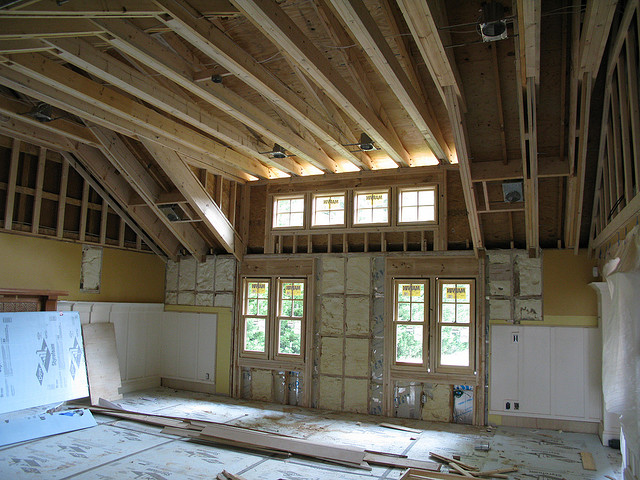Our home was built about 11 years ago. I remember watching it turn from a pile of dirt into a place where we now spend the majority of our time as a family. We watched the foundation go in, the studs go up and the placement of drywall and insulation. If only we knew then what we know now- that toxic building materials were being used in and behind the walls of our home.
We work hard to keep it our home safe and free of harmful chemicals. We avoid bringing toxins into our homes by taking our shoes off [2], using non-toxic cleaners, eating organic foods [3]and using safe personal care products.
However, the World Health Organization estimates that indoor air pollution accounts for nearly 3 percent of all deaths worldwide. Turns out there are many other sources which can impact air quality –and many of them are in our walls.
DRYWALL
Drywall (plasterboard, gypsum board) is a layer of gypsum pressed between two sheets of paper and is used to construct walls and ceilings in houses.
Issues with drywall
Most drywall itself isn’t toxic (unless it was part of the defective drywall [4] imported into the US from China), but the plaster-like mud substance used to cover seams usually does contain toxins [5]. In a Harvard study done for the EPA [5], the glue joint compound was found to release as many as 25 volatile organic compounds or VOC’s. There’s more bad news: the release of these VOC’s into the air of your home increases over time. The higher the temperature and humidity the more VOC’s are released.
Another issue with drywall-if there’s moisture mold [6] can grow on the drywall opening the door to a whole slew of health issues.
On a global level the process of manufacturing drywall is very energy intensive and contributes to as much as one percent of the greenhouse gas emissions in the United States. [7]
Alternatives to drywall
If you are remodeling or building consider a natural replacement for drywall such as EcoRock or Durra Panels.
PRESSED WOOD
One of my all time favorite classic TV shows has one of the most iconic houses — the Brady Bunch. [8] It’s also the epitome of pressed wood-think dark wood paneling. Pressed wood is made up of shavings and chips of wood which are glued together under high pressure. The glue that holds the wood particles in place can contain urea-formaldehyde (popular in home construction in the 70’s).
Issues with pressed wood
Formaldehyde [9] is a known human carcinogen, linked to nasal and brain cancers and possibly leukemia. It can also set off watery eyes, burning eyes and throat, breathing difficulties and asthma attacks.
How to reduce exposure
- Don’t be afraid to ask about the formaldehyde content of pressed wood products, including building materials, cabinetry, and furniture before you purchase them.
- If you live in an older house with pressed wood paneling or insulation, the good news is that it releases less formaldehyde as it ages. Using a dehumidifier and air conditioning to control the indoor temperature and humidity can help. Today, pressed wood products also are more closely regulated to reduce formaldehyde emissions.
INSULATION
Insulation can be made from a variety of materials. Fiberglass insulation, a man-made mineral fiber constructed from a variety of materials, such as sand and recycled glass, is the most popular form of insulation in the United States. I remember seeing the large rolls of pink insulation before they were placed in our walls and roof area.
Issues with insulation
Over the years health concerns have arisen due to insulation materials such as asbestos and urea formaldehyde foam insulation. Fiberglass insulation is dangerous when the fine glass fibers become air-borne and are breathed in during the installation process-a similar problem discovered with asbestos about two decades ago. Fiberglass insulation can also cause a variety of health problems from skin irritations cancer.
Alternative insulation
Choose insulation with no added formaldehyde. The greenest options for insulation are natural materials such as hemp, coconut fiber or sheep’s wool.
What you can do: healthy home action plan
- Do Your Part and take charge of your indoor air quality. If you think your air is compromised increase ventilation by opening windows and doors. You may also want to consider purchasing an high efficiency particulate air (HEPA) purifier that will help keep your home free of toxins.
- Join Moms Clean Air Force [11]– a group of moms and dads joining together to fight for our kids’ right to clean air.
- Take action with Healthy Child Healthy World. [12]
What do you do to keep the air clean in your home?
[Photos used under Creative Commons from Brock Builders [13]and Ryan McFarland/Flickr]

